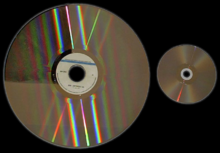parent nodes: HorizonResearchLab | Laser Disc | Mick Kanic

The Laser Disc (LD) is a home video format and the first commercial optical disc storage medium, initially licensed, sold and marketed as MCA DiscoVision (also known simply as "DiscoVision") in the United States in 1978. Its diameter typically spans 30 cm (12 in). Unlike most optical-disc standards, Laser Disc is not fully digital, and instead requires the use of analog video signals.
Although the format was capable of offering higher-quality video and audio than its consumer rivals, VHS and Betamax videotape, Laser Disc never managed to gain widespread use in North America. This was largely due to the high cost of the players and their inability to record TV programs. It eventually did gain some traction in that region and became somewhat popular in the 1990s. It was not a popular format in Europe and Australia.
By contrast, the format was much more popular in Japan and in the more affluent regions of Southeast Asia, such as Hong Kong, Singapore, and Malaysia, and was the prevalent rental video medium in Hong Kong during the 1990s. Its superior video and audio quality made it a popular choice among videophiles and film enthusiasts during its lifespan. The technologies and concepts behind Laser Disc were the foundation for later optical disc formats, including Compact Disc (CD), DVD, and Blu-ray (BD). 